As in almost any tropical forest, there is a variety of lizards. We found at least two Kendall's Rock Geckos (Cnemaspis kendallii), a lizard of mature forests largely confined in Singapore to the Central Catchment and the Bukit Timah Reserve. It is supposed to prefer to cling to rocks and tree trunks; here are two individuals, one on each of the species' chosen substrates.
The Striped Sun Skink (Eutropis rugifera) is also confined to forest reserves in Singapore, where it is considered to be an endangered species. This one has escaped from some predator, shedding its tail in the process.
The most fascinating of Southeast Asia's arboreal reptiles are surely the gliding lizards, popularly known as flying dragons. We found several Black-bearded Gliding Lizards (Draco melanopogon) along the trail through the Central Catchment, mostly clinging to the trunks of trees, doing their best to pass themselves off as thin twigs.
Males, tough, are actually fairly striking at close range, with their orange throats and black dewlaps.
When they choose, they draw attention to themselves by repeatedly erecting the dewlap - a display that recalls the vaguely similar displays of Anolis lizards in the Americas.
Females lack the dewlap and coloured throat, but these photographs show the feature that makes Draco lizards truly unique. The folded finlike structure along the lizard's side is a sail, supported on extensions of the ribs. The sails, often brightly coloured (though not particularly so in this species), enable these lizards to launch into the air and glide up to 9 metres to their next perch.
Midday is never the best time for birding, but I did have a chance to photograph this Greater Racket-tailed Drongo (Dicrurus paradiseus), sans rackets.
Singapore, like southern Florida, has its share of exotic parrots, but the Long-tailed Parakeet (Psttacula longicauda) is a native. It is a forest bird, one that may be being displaced in more settled areas by its introduced cousins such as the Red-breasted Parakeet (P. alexandri).
Mammal-watching, by day, is most likely to involve squirrels, and we found both of Singapore's surviving native diurnal species, the common Plantain Squirrel (Callosciurus notatus)...
...and the considerably smaller Slender Squirrel (Sundasciurus tenuis). Among other things, Slender Squirrels eat the soft bark of forest trees, as the animal in the lower picture appears to be doing.
Singapore has its own distinctive population of Long-tailed Macaque (Macaca fascicularis), differing in size and a few other features from those found in surrounding countries.
Snakes are shy creatures, and (like this one, much to the delight of the local flies) are more likely to be seen dead than alive.
However, we did come across a live snake at the end of our walk, a Spotted Keelback (Xenochrophis maculatus), a small species confined to the central forests. It appears to be non-venomous and, like most other snakes, it is not aggressive.
Snakes are frequently the victims of ticks (I have seen enormous ones on a boa constrictor in Costa Rica). This on was carrying a small brownish tick on the top of its head; compared to some victims, it appeared to be getting off lightly.
As we were leaving the reserve, a Crimson Sunbird (Aethopyga siparaja) appeared in a flowering shrub not far from the gate. The most colourful of Singapore's sunbirds, it made for a suitable encounter to end our walk - in October 2015, a little more than a year later, the Crimson Sunbird was declared Singapore's National Bird.
Singapore, like southern Florida, has its share of exotic parrots, but the Long-tailed Parakeet (Psttacula longicauda) is a native. It is a forest bird, one that may be being displaced in more settled areas by its introduced cousins such as the Red-breasted Parakeet (P. alexandri).
Mammal-watching, by day, is most likely to involve squirrels, and we found both of Singapore's surviving native diurnal species, the common Plantain Squirrel (Callosciurus notatus)...
...and the considerably smaller Slender Squirrel (Sundasciurus tenuis). Among other things, Slender Squirrels eat the soft bark of forest trees, as the animal in the lower picture appears to be doing.
Singapore has its own distinctive population of Long-tailed Macaque (Macaca fascicularis), differing in size and a few other features from those found in surrounding countries.
Snakes are shy creatures, and (like this one, much to the delight of the local flies) are more likely to be seen dead than alive.
However, we did come across a live snake at the end of our walk, a Spotted Keelback (Xenochrophis maculatus), a small species confined to the central forests. It appears to be non-venomous and, like most other snakes, it is not aggressive.
Snakes are frequently the victims of ticks (I have seen enormous ones on a boa constrictor in Costa Rica). This on was carrying a small brownish tick on the top of its head; compared to some victims, it appeared to be getting off lightly.
As we were leaving the reserve, a Crimson Sunbird (Aethopyga siparaja) appeared in a flowering shrub not far from the gate. The most colourful of Singapore's sunbirds, it made for a suitable encounter to end our walk - in October 2015, a little more than a year later, the Crimson Sunbird was declared Singapore's National Bird.






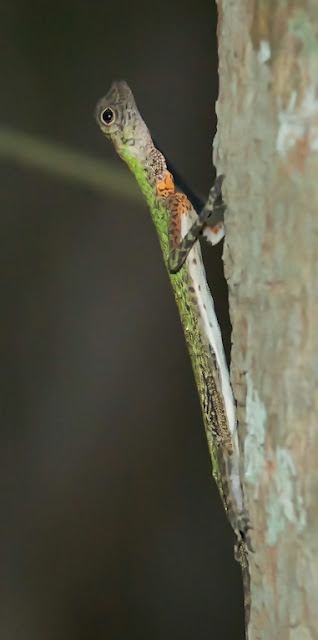


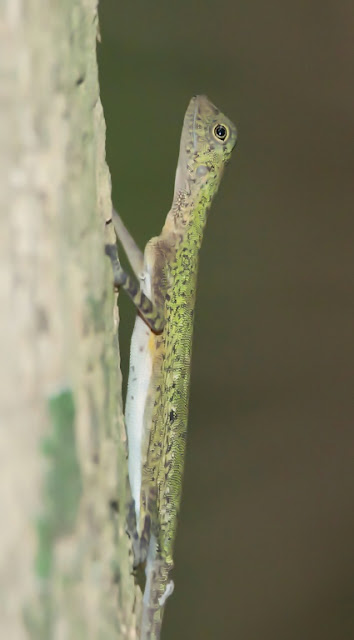




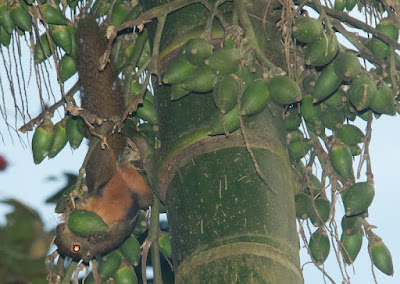



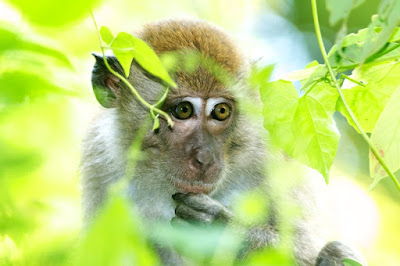

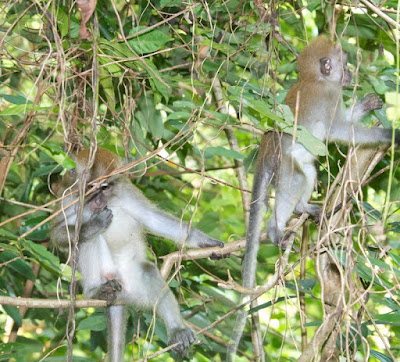







No comments:
Post a Comment